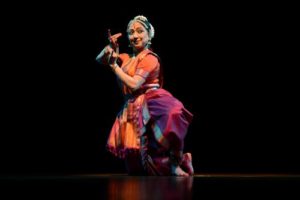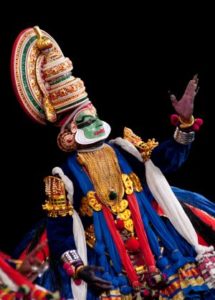Charishnu – Desire to move on

Have you ever imagined what happens when titans unite? What happens when the world’s pre-eminent dancers of six very different classical dance forms of India share the stage? Is there is a storm, an earthquake or a tsunami? Well, you will know it soon as in the coming month, one-of-its-kind show, Charishnu will be showcased at the National Center of Performing Arts in Mumbai, celebrating 50 years of service to arts by NCPA.
The conception of Charishnu began over a decade back when, in 2007, Padma Shri Leela Samson was asked by the Ministry of Tourism to create a production that would include several of India’s dance forms. It was for the opening of an India tourism office in Shanghai. She immediately thought of dancers whose work had created waves in their respective forms and who would be willing to participate in a joint production under her able guidance.
The prime movers and the artistes she chose then have not been replaced since by any other group in those forms. They are now like a family where the individual dancers and original choreographers in those styles are not bigger than the production itself. Charishnu, as they named the production, means “the desire to move” and has since been performed at regular intervals both in India and abroad to huge appreciation. The best thing — the reviews about the show is that the audiences feel Charishnu is a show that makes them “proud to be an Indian”.
This production consists of Priti Patel and her collaborator Imocha Singh for Manipur and the martial art form, Thang-ta; Aruna Mohanty for Odissi, Sadanam Balakrishnan for Kathakali and Mohiniattam, Aditi Mangaldas for Kathak, Mahesh Vinayakaram for drum ensemble and Bharatanatyam under the direction of Ms Samson with lights designed by Gyan Dev.
Speaking of Charishnu, Aditi Mangaldas says, “This is a dance production which has short vignettes of many dance styles from India as well as a percussion interlude.”
Each dancer was requested to bring an abstract seven-minute piece that represents his/ her form to the production. “I was inspired to bring together two pieces. One is an excerpt from the Raasleela of Krishna and the gopis which began with an excerpt from the Sankirtana tradition,” shares Priti Patel, adding, “The second piece was more challenging. It is a presentation of the pre-Vaishnavite tradition of Lai Haraoba and Thang-ta, the ancient martial art form of Manipur. Both are very different – one being soft and lyrical, the other, strong and dynamic. While in the Raasleela, the lyrics used are from Jayadeva’s Geeta Govinda, the dance forms of Maibi and Thang-ta are accompanied by the sound of drums and a string instrument, pena,” she says. Everyone thought of original music for the production. Thereafter, Leela Samson knit the forms together, making them meet each other in a way that made for a seamless production.
There have been many on collaborations by various artistes in the past and in the present too. In the past, it was exciting to see the coming together of Kelucharan Mohapatra and Birju Maharaj, and, on the odd occasion, Mohapatra and Kalanidhi Narayanan too. There were times when Yamini Krishnamurthy, Sonal Mansingh and Uma Sharma made appearances together.
Exposure to all the forms and a new familiarity with each other did exist, but each dancer was so preoccupied with the long training and performing of their own forms, that they had limited time for collaborations. There were times when some famous jugalbandis failed to impress audiences, both in the world of Hindustani and Carnatic music as well as in different dance forms.
With Charinshu, however, things have been a bit different. The response of the audience has been encouraging. Vinayakaram, son of the illustrious TH Vikku Vinayakaram, says, “In my view, Charishnu is the ultimate portal of Indian dance and percussion and has brought a certain oneness among the artistes.” Mangaldas feels the same way. “What Charishnu symbolises to me,” she says, “is unity in diversity – the hallmark of India. It does not try to iron out differences, but instead it celebrates the uniqueness of each style.”
This show is a sublime sangam. It has to be said that lighting and soundscape play an important part in presentations that have both live sound and pre-recorded sound. Sai Shravanam of the studio Resound India in Chennai is an “unfailing rock” who brings the different levels of music together in Charishnu but it is working with the wonderful dancers that has brought the most pleasure to Leela Samson who directed this magnificent show under her artistry. Each of the dancers carries responsibilities of their own group choreographies independent of Charishnu, apart from the institutions they individually run. But when they come together to perform in Charishnu, they bring with them their high sense of professionalism and discipline. And when they watch each other perform, they are inspired.
Balakrishnan, who has practiced Kathakali all his life, says, “Participating in Charishnu made me understand classical dance forms other than Kathakali. With this collaboration, I admire and respect our great heritage in the varied dance forms of India. I can see the same feeling in dancers of other forms, and this, I think, has been the best outcome of Charishnu.” Mangaldas has, inadvertently, found ways to reinforce her own learning. “Besides presenting my own piece, I have stood in the wings and seen great artistry unfold, in a variety of forms, music, colour, structure and literature. I have been able to learn something from each and that has helped enhance my own dance,” she says.
Speaking from the heart, Leela Samson said, “The dancers within each group have, over the years, changed, but what is important is that the work has an original conviction that is special and remains constant. Conviction and discipline can be infectious.” She further adds, “This infection spreads through everyone who is a participant, one sees a new face in each group from time to time, but they catch the import of the others and raise their game for the presentation. This is what makes my Charishnu special.”
This year is very special for NCPA as it celebrates 50 years of service to the Arts. NCPA is an unique arts centre nurturing the dreams of artistes across five genres- Western and International music, Indian music, Theatre, Photography and Dance. It is the home to one of the finest professional International Symphony orchestras of the country and has been a temple of good quality arts for decades. This year NCPA celebrate 50 years with some exceptional performances such as Charishnu. This year also marks the 10th anniversary of NCPA long-time collaborator Sahachari Foundation. Together, they bring back this mega Indian classical dance production.
Speaking about this extraordinary show, renowned Odissi exponent Swapnokalpa Dasgupta, head – dance programming, NCPA, said, “What makes Charishnu unique is the constellation of icons who have collaborated with the legend Leela Samson. This production is an iconic group work, where Leela ji has woven Bharatanatyam, Odissi, Manipuri, Mohiniattam, Kathakali and Kathak along with live drumming and Martial arts Thangta.”
“This one-of-a-kind grand production with nearly 50 people was conceived over a decade back when multi-dance style collaborations were rare. Most fascinating part of Charishnu is that even after a decade it has been able to retain the same collaborating dancers who are some of the biggest names in their fields.”
Sandip Soparrkar holds a doctorate in world mythology folklore, is a World Book Record holder, a well known Ballroom dancer and a Bollywood choreographer who has been honoured with three National Excellence awards, one National Achievement Award and Dada Saheb Phalke award by the Government of India. He can be contacted on sandipsoparrkar06@gmail.com





